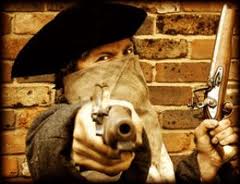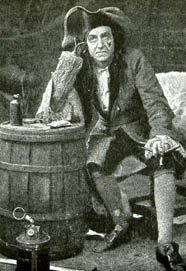Piracy was a specialized job – blue-collar for sure, but not
without its requirements for knowledge and specialization. Every position on
the boat required some kind of specialized knowledge.
Sailors – The very
lowest position on a pirates ship, that of common sailor, required about a year
of training. Every rope, sail, and bit of wood on a ship had a specialized name,
and a sailor had to know them all, understand their function, and remember how
to use them. Sailors held landsmen in contempt, as people who were brainless
for not understanding even the most basic information about the important task
of sailing. In the rare occasion when a landsman joined a pirate crew, he
either had specialized skill such as medicine or carpentry, or he would be put
on the training program, which mostly consisted of being handed a piece of rope
(picking up a rope on his own was considered too much mental activity for a
landsman) and told to pull.
Topmen were a special
class of sailors, skilled in climbing through the topmost rigging of the ship.
Topmen had the skills of a circus acrobat, able to haul lines and tie knots
while hanging upside down, or run along a ship’s horizontal spar, forty feet in
the air while the ship tossed and pitched. Most sailors never reached this
illustrious level of skill.
The Cook had
specialized skills for cooking at sea. Often these people did little more than
heat up salted beef, reconstitute dried peas, and measure out quantities of
ship’s biscuit. A more talented cook took plunder in the form of live animals,
fruit, fine wine, captured cheeses and sausages, fresh fish, and exotic
spices, and turned it all into very fine eating for a pirate crew. The most famous
fictional cook was Long John Silver, who not only starred in the novel Treasure
Island, but also had a chain of seafood restaurants named after him.
The ship’s Surgeon
was not as prestigious a position as it sounds to a modern ear. We think of surgeons as being
the highest form of doctor. In the 18th century, the title surgeon
denoted someone able to lop off arms and legs with a knife and saw. Training
was on-the-job, and consisted mostly of learning to take a limb of cleanly at
the nearest joint before the patient bled to death. When there was no surgeon,
the carpenter might be pressed into service. The tools were much the same.
Gunners – Every cannon
on a warship required an assigned crew, a group of 3-12 individuals who practiced
operating the weapon and firing. Specialized positions included “carriers” who
moved powder and shot, “spongers” who cleaned burning debris out of the barrel,
“loaders” who pushed powder and shot into the cannon, “layers” ran the gun into
position, and the gun captain, the leader for the gun team, primed the gun and
fired it.
The Master Gunner
was in charge of all the cannons, and organized cleaning, storage, preparing powder
charges, maintaining ammunition, and repairing guns that had become damaged. He
was assisted by one or more Gunner’s
Mates.
Another technical position on a sip was the Carpenter. The carpenter and his
assistants, the carpenter’s mates, were so necessary that a pirate crew would
kidnap unwilling individuals to fill these positions if necessary. The
carpenter repaired the ship if it was damaged, plugging leaks in emergencies,
cleaning the seaweed and barnacles from the bottom to keep the ship fast and
strong, and performing more extensive repairs to planking and masts as needed.
The Bosun (a
contraction of the word “boatswain”) was the man in charge of the use of sails
and rigging. He made sure that the ship was properly powered, that sails were
used properly, that the ropes were preserved with tar and rigged so that they
worked properly. He was the manager of the common sailors. He also had odd jobs
like using a special whistle to signal the crew for mealtime and special
activities. He was also the person in charge of dispensing justice in the form
of whippings, as required.
The Navigator was
responsible for finding a ship’s position, and guiding the ship to where it was
supposed to be. Navigators were highly trained individuals, highly paid in the
merchant marine, and unlikely to turn to piracy. Like carpenters, they often
joined a pirate crew because they had been forced.
The Quartermaster was
technically the second in command on a pirate ship. As the captain was in charge
of obtaining plunder, the quartermaster was in charge of distributing plunder.
He also kept track of ship’s stores, including food and water. When pirates
stole valuables, instead of cash, the quartermaster found fences for the goods
and sold them for the best possible prices. When the ship wasn’t in battle, the
quartermaster was in charge. In a pirate crew, if a captain was killed or
deposed, the quartermaster was the next logical choice for the position. Calico
Jack Rackham was Charles Vane’s quartermaster before Vane was voted out, and
was elected captain after him.
Captain – The pirate
captain gets all the notoriety, but in fact, captains were no more than members
of the crew most of the time. A captain could propose a plan for capturing ships,
but the crew were free to out-vote him. The captain inhabited the grand aft
cabin of a ship, but any member of the crew was free to enter it at any time. The
pirate captain was in charge during chase and battle. If he was an effective
leader, however, chasing and capturing ships took up much of the crew’s time.
Captains were notorious largely because the institutions
hunting pirates – Navies and colonial governors - were top-down organizers. On a navy or
civilian ship, the captain was a gentleman, of a different social class
entirely than sailors or even officers. In a pirate crew the captain might have
risen from the position as a common sailor through talent. These people had
much more in common with their crews. They
ate the same food, drank the same liquor, faced the same dangers. True, pirate
captains made more money than their crews, but the pirate captain’s share was
only twice the amount earned by the lowest of sailors.


























